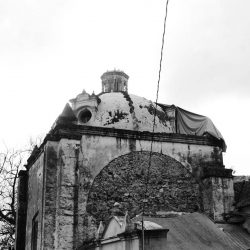If you don’t want to get addicted, don’t go to Oaxaca city. It is the culinary capital of Mexico, but it is also a cultural melting pot wit an irresistible amount of energy and joy of life. It is that feeling that makes visitors and expats come back again and again to this heartland.
(there is also a photo album about Oaxaca)
Nothing illustrates that maybe better than a tour I did in the botanical gardens. Here was an American guide, enjoying her days as a pensioner by staying several months a year in the city, explaining how beautiful and diverse fauna and flora in this region was. She looked just as proud as the locals of Oaxaca, the breeding ground of so many cultures and, yes, so many species.
CONTENTS
General introduction
Food and drinks
Activities / Things to do
Getting there and getting around
Miscellaneous
General introduction
Food and drinks
Activities / things to do
- botanical garden: admittedly I am not a huge fan of these usually, because you are just admiring flora without having the background knowledge. That’s why the Oaxaca one is so good: you have to book a guided tour. In ninety minutes he or she will tell you a lot about the species on display here. And they have so many languages on offer, it will be hard for you to find an excuse not to visit
- MACO: because the city is well-known as an epicentre for (inter)national artists, it hardly is a surprise you can find galleries everywhere. It is almost surprising that only the MACO is a big art institution in the city. It has excellent temporary exhibitions on contemporary art on display, though it isn’t so big it would take you hours to digest everything
- Centro Fotografico Alvarez Bravo: this is a beautiful delicate photography museum, been around for several decades. It also doesn’t shy away from political issues, which is a good thing in these historically charged regions of the country
- churches: the Catedral de Nuestra Senora de la Asuncion on the northern side of the Zocalo simply cannot be missed. Even more impressive though is the Templo Santo Domingo de Guzman. The former monastery is decorated with ridiculous amounts of gold inside, but somehow retains an eery feel
- If you feel like archaeology, adjacent Museum of Cultures is something for you. It is located in the former monastery buildings which in itself is already worth a visit
- Talking about archaeology, the main surprise of Oaxaca is actually located just outside the city. On top of the surrounding hills, invisible from the city, is Monte Alban. It is one of the oldest civilizations in the world. It is an easy daytrip (more information here)
- looming over the northwestern edge of the city is the fantastic Auditoria Guelaguetza. It is a more or less classic amphitheatre, covered by a tent-like roof. This is a massive place, seating 12,000, and hosting regular concerts from Mexican and international artists, but also ballet and opera
- If you make your way down or up from the amphitheatre, pay a visit to the northern barrios of Oaxaca. Xochimilco and Estrella for example have lots of street art, though you can find great pieces everywhere in this lively city
- Markets: another treat in Oaxaca are the markets. Most tourists will not venture beyond the beautiful La Merced in the city centre, a nice but somewhat neatly organized thingy. The much better, more Mexican (=chaotic) one is the Mercado 20 de Noviembre. This is a seemingly endless maze of small shops in narrow alleys, where you can literally buy anything you need. Watch your belongings and let Mexican life take you over
Getting to Oaxaca and getting around
- Plane: from the surrounding hills you can see Oaxaca airport, that is how close it is to the city. It even has international connections
- Car: 300 miles or 500km south of Mexico City on easygoing roads, this trip will take most of your day
- Buses: Oaxaca is the main hub to and from all other destinations in the south. ADO is the main service provider, with an excellent modern terminal on the northern edge of the city center. This one connects you to Mexico City, Puerto Escondido, Tuxtla Gutierrez / San Cristobal de las Casas and many more
- Getting around: just walk. The grid-like city centre is quite compact. Only when venturing beyond (Monte Alban, Auditorio) you might want to take a taxi
Miscellaneous
- Weather: continental and warm, though not as steady as other regions of Mexico. Due to its isolated location between the hills, the city is either shielded from bad weather or gets caught up in it for several days. Apart from that, the usual dry-wet season pattern applies
- Safety: generally good. As this is a major tourist destination though, be cautious when there are huge crowds or no crowds at all. The latter may happen when you walk to Monte Alban through the poorer western parts of town









